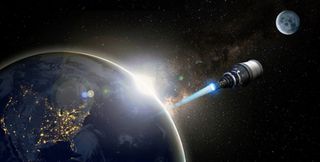
The U.S. military aims to get a nuclear thermal rocket up and running, to boost its ability to monitor the goings-on in Earth-moon space.
The Defense Advanced Research Projects Agency (DARPA) just awarded a $14 million task order to Gryphon Technologies, a company in Washington, D.C., that provides engineering and technical solutions to national security organizations.
The money will support DARPA's Demonstration Rocket for Agile Cislunar Operations (DRACO) program, whose main goal is to demonstrate a nuclear thermal propulsion (NTP) system in Earth orbit.
Related: Superfast spacecraft propulsion concepts (images)
NTP systems use fission reactors to heat propellants such as hydrogen to extreme temperatures, then eject the gas through nozzles to create thrust. This tech boasts a thrust-to-weight ratio about 10,000 times higher than that of electric propulsion systems and a specific impulse, or propellant efficiency, two to five times that of traditional chemical rockets, DARPA officials wrote in a description of the DRACO program.
Such improvements in propulsion technology are needed for "maintaining space domain awareness in cislunar space — the volume of space between the Earth and the moon," the DRACO description reads.
Gryphon will work to help make this vision a reality, using the newly awarded $14 million.
Get the Space.com Newsletter
Breaking space news, the latest updates on rocket launches, skywatching events and more!
"We are proud to support DRACO and the development and demonstration of NTP, a significant technological advancement in efforts to achieve cislunar space awareness," Gryphon CEO P.J. Braden said in a statement.
DARPA is not alone in seeing great promise in NTP systems. NASA Administrator Jim Bridenstine has lauded the technology's potential for crewed Mars exploration, for example, noting that NTP-powered spacecraft could get astronauts to the Red Planet in just three to four months — about half the time needed with traditional chemical rockets.
"That is absolutely a game-changer for what NASA is trying to achieve," Bridenstine said during a meeting of the National Space Council last year. (NASA is working to get astronauts to the Red Planet in the 2030s.) "That gives us an opportunity to really protect life, when we talk about the radiation dose when we travel between Earth and Mars."
Mike Wall is the author of "Out There" (Grand Central Publishing, 2018; illustrated by Karl Tate), a book about the search for alien life. Follow him on Twitter @michaeldwall. Follow us on Twitter @Spacedotcom or Facebook.
Join our Space Forums to keep talking space on the latest missions, night sky and more! And if you have a news tip, correction or comment, let us know at: community@space.com.

Michael Wall is a Senior Space Writer with Space.com and joined the team in 2010. He primarily covers exoplanets, spaceflight and military space, but has been known to dabble in the space art beat. His book about the search for alien life, "Out There," was published on Nov. 13, 2018. Before becoming a science writer, Michael worked as a herpetologist and wildlife biologist. He has a Ph.D. in evolutionary biology from the University of Sydney, Australia, a bachelor's degree from the University of Arizona, and a graduate certificate in science writing from the University of California, Santa Cruz. To find out what his latest project is, you can follow Michael on Twitter.
-
newtons_laws At last! Nuclear Thermal Rockets could have been in use years ago if the work of the successful NERVA program in the 1960s had been continued. Of course Von Braun envisaged using nuclear thermal rockets in his plans for a manned Mars mission.Reply -
just_some_dude Do they really need a fast rocket just to be "aware" of what is happening between the earth and moon?Reply
